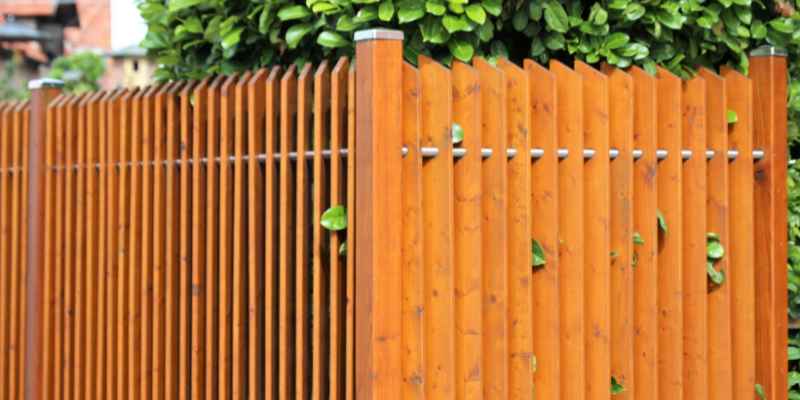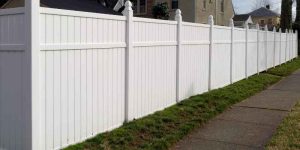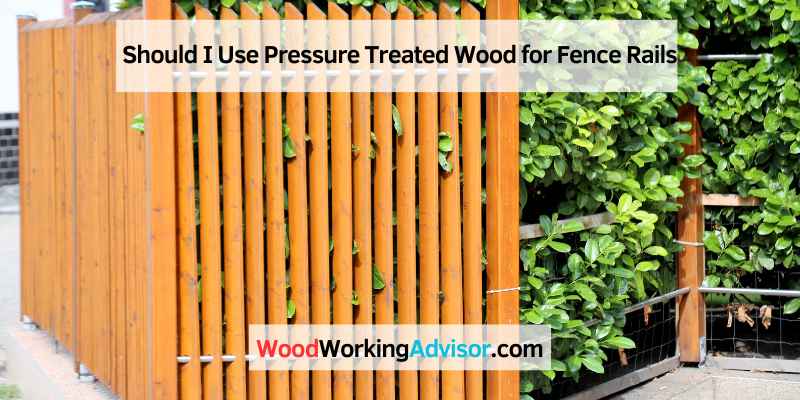Pressure-treated wood is the best choice for fence rails. You should use pressure-treated wood for fence rails because it lasts longer and needs minimal maintenance, making it the best quality in the market.
Pressure-treated wood has numerous benefits, including durability and resistance to rot. Fence rails are one of the most important components of a fence, and your choice of materials will determine your fence’s lifespan and structural integrity. Should you use pressure-treated wood for fence rails?
While it may cost more than other materials, pressure-treated wood has numerous benefits that make it worth considering. One of the benefits is its durability and resistance to rot, making it an ideal choice for outdoor structures that aren’t going to come into a lot of contact with people, such as a fence or even a roof. We’ll explore the reasons why pressure-treated wood is the best option for fence rails and the various alternatives available to you.
Fundamentals Of Building A Fence With Pressure Treated Wood
Using pressure-treated wood for fence rails is always recommended as it is durable and can withstand the elements better, increasing the longevity of your fence. Even though untreated cedar may hold up well, using pressure-treated wood is the best quality and requires minimal maintenance.
Consider the numerous benefits of pressure-treated wood when building your fence.
Pressure-treated wood is a popular choice for fence rails, as it is more durable and less susceptible to insects and rot than untreated wood. Building a fence with pressure-treated wood involves several steps, including excavation, marking posts and spacing, attaching fence rails and pickets, and attaching pickets to posts.
Excavation
Excavation is necessary to ensure that the fence posts are stable and secure. The depth of the hole should be at least one-third the length of the post, and the width should be wide enough to accommodate the post. Dig the hole with a post-hole digger or shovel, and make sure the bottom of the hole is level.
Marking Posts and Spacing
Once the holes are dug, mark the posts at the desired height for the fence rails. Use a measuring tape and level to ensure that the posts are level, and space them evenly according to the width of the fence rails. Use a string line or chalk line to ensure that the posts are aligned.
Attaching Fence Rails and Pickets
Attach the fence rails to the posts using galvanized screws or nails. Make sure the rails are level and evenly spaced, and use blocking material in between the rails for added support. Install the pickets by nailing them to the rails, leaving a small gap between each picket for expansion due to temperature changes.
Attaching Pickets to Posts
Finally, attach the pickets to the posts using galvanized screws or nails. Make sure the pickets are level and evenly spaced, and use a spacer to ensure consistent spacing between each picket. Seal and paint the fence to protect it from the elements.
Conclusion
Building a fence with pressure-treated wood involves several steps, including excavation, marking posts and spacing, attaching fence rails and pickets, and attaching pickets to posts. By following these steps, you can create a sturdy and durable fence that will last for years to come. Just remember to choose pressure-treated wood for added durability and protection against insects and rot.
Choosing The Type Of Wood For Fence Rails
Pressure treated wood is the best choice for fence rails as it is more durable and requires minimal maintenance. However, if you want to use untreated wood, it depends on the environment and how long you want the fence to last.
Cedar may hold up fairly well.
taken. When choosing the type of wood for fence rails, the decision can directly impact the fence’s strength and longevity. In this article, we will look at two common types of wood used for fence rails: pressure treated pine wood and cedar wood. We will also explore the difference between treated and untreated wood.
Pressure Treated Pine Wood
Pressure treated pine wood is a staple in the fencing industry due to its durability and affordability. This wood is treated with a chemical preservative that helps protect it from termites, rot, and decay. Pressure treated wood comes in a variety of grades, and the higher the grade, the better the wood quality. The main drawback of using pressure treated wood for fence rails is that it has a tendency to warp and twist over time.
Cedar Wood
Cedar wood is another popular wood choice for fence rails due to its natural beauty and resistance to decay. Cedar wood has natural oils that make it resistant to insect infestations, rot, and decay. In addition, cedar wood has a beautiful warm color that looks great in any outdoor space. Although cedar wood is more expensive than pressure treated wood, it’s an excellent choice for anyone looking for a long-lasting high-quality fence.
Treated Vs Untreated Wood
Choosing between treated and untreated wood is a crucial decision when building a fence. Treated wood has been chemically treated to resist rot, decay, and insect infestations. Untreated wood, on the other hand, has not been chemically treated and is more susceptible to rot and decay. Treated wood is more durable and long-lasting than untreated wood, but it does come with some potential health risks. If you plan to use treated wood, make sure to wear gloves and a mask to avoid any chemical exposure. Overall, treated wood is an excellent choice for building fence posts and parts that are in contact with the ground.
In conclusion, choosing the right type of wood for your fence rails is a crucial decision that will directly impact your fence’s strength and longevity. Pressure treated pine wood and cedar wood are two popular choices, each with its unique qualities. You must also decide between treated and untreated wood, considering the health risks and longevity of your fence. By choosing the right wood and maintaining it properly, you can enjoy a beautiful, long-lasting fence for years to come.
Benefits Of Using Pressure Treated Wood For Fence Rails
Pressure treated wood is the best option for fence rails as it offers numerous benefits. It lasts longer, has minimal maintenance needs, and is more durable than other types of wood in the market. So if you’re considering installing a fence, pressure treated wood is undoubtedly the best choice.
If you are thinking about installing a fence, using pressure treated wood for fence rails is a wise decision. Not only is it an affordable and readily available option, but it also offers a range of benefits that make it an excellent choice for your project.
Durability
One of the most significant benefits of using pressure treated wood for fence rails is its durability. Treated wood is infused with chemicals that keep it from deteriorating quickly, making it ideal for outdoor use. Especially if you live in an area that sees harsh weather conditions, pressure treated wood is an excellent option for long-lasting durability.
Resistance To Rot
Another benefit of using pressure treated wood for fence rails is its resistance to rot. Treated wood is infused with chemicals that protect it from rot and decay. As a result, it can withstand long-term exposure to moisture, making it ideal for use in areas with high humidity levels or frequent rain.
Minimal Maintenance
Using pressure treated wood for fence rails also means minimal maintenance requirements. Treated wood is designed to withstand the elements, and it doesn’t require regular staining or sealing like some other types of wood. This makes it a convenient and low-maintenance option for homeowners who don’t want to spend a lot of time or money maintaining their fences.
Overall, using pressure treated wood for fence rails is an excellent choice for your fence project. Its durability, resistance to rot, and minimal maintenance requirements make it a practical and worthwhile investment that will last for years to come.
Concerns Over Using Pressure Treated Wood For Fence Rails
Using pressure treated wood for fence rails may pose some concerns, as chemicals used in the treatment process can potentially harm the environment and human health. However, it is still recommended for posts and parts that will be in contact with the ground as it lasts longer, while choosing untreated cedar may still be an option for other fence parts depending on the environment.
with it, and this is one of the primary concerns when it comes to using it for fence rails. The chemicals used in the pressure treatment process, mainly copper, chromium, and arsenic, are toxic to humans and can cause various health problems. In this article, we will explore the health impacts of using pressure treated wood for fence rails and the alternatives to it.
Health Impacts For People Who Handle It
The chemicals used for pressure treatment of wood are known to cause a range of health problems for people who handle them. Prolonged exposure to the chemicals can lead to skin irritation, nausea, vomiting, respiratory problems, and even cancer. The risk of exposure is higher for people who work with pressure treated wood regularly, such as fence installers or builders.
To reduce the risk of health problems caused by exposure to chemicals from pressure treated wood, it is essential to wear protective gear, such as gloves, goggles, and a respirator while handling it. It is also recommended to avoid burning pressure treated wood as it releases toxic fumes.
Alternatives To Pressure Treated Wood
Although pressure treated wood is a popular choice for fence rails, various alternatives can be used that are safer and more environmentally-friendly. Some of these alternatives include:
- Cedar wood: Cedar wood is naturally resistant to rot and insects and does not need to be pressure treated to remain durable.
- Redwood: Redwood is also naturally resistant to decay and insect damage and can be used without pressure treatment for fence rails.
- Composite wood: Composite wood is made from recycled materials and is resistant to rot, insects, and warping. It is a long-lasting and durable option for fence rails.
- Metal: Metal fence rails are also a durable and long-lasting alternative to pressure treated wood.
In conclusion, while pressure treated wood may be a popular choice for fence rails, it is essential to consider the health risks associated with it. Alternatives such as cedar, redwood, composite wood, and metal offer a safer and more sustainable choice that can last just as long as pressure treated wood. It is always best to consult with a professional fence installer to determine the most suitable choice for your specific fence needs.
Other Types Of Wood For Fence Rails

When it comes to fence rails, pressure treated wood is a popular choice for its durability and longevity. However, untreated cedar may hold up fairly well depending on the environment. Other types of wood for fence rails include pine, redwood, and douglas fir.
Whitewood:
Whitewood is a softwood that is easy to work with and has a light color that can be stained to match your outdoor decor. It is low cost compared to other woods, but it is not as resistant to insects, decay, and weather damage. This wood can shrink, warp or crack over time, so it needs to be treated regularly for maintenance.
Douglas Fir:
Douglas Fir is a great choice for fence rails because it is strong and durable. It is also resistant to decay, warping and insect attack. This wood is naturally attractive and can be stained or painted to match your outdoor decor. However, it is more expensive than whitewood, but it is worth the cost due to its durability and strength.
Redwood:
Redwood is a popular wood for fence rails due to its natural beauty and resistance to decay and insects. It is easy to work with and can be stained to your desired color. This wood is more expensive than other woods, but it is worth the investment because it lasts a long time and can withstand environmental exposure.
Ultimately, you need to consider the level of exposure to the elements and the length of time you want your fence to last when choosing a wood for your fence rails. While other woods may provide a cheaper alternative, pressure-treated wood is treated to withstand rot, decay, and insect damage, meaning it will last longer and require less maintenance. If you can afford a more expensive wood option, redwood or douglas fir might be a better option. However, it is important to note that pressure-treated wood may have some health impacts on people who work with it, so precautions should be taken when handling and installing it.
Maintenance Of Pressure Treated Wood Fence Rails
When it comes to fence rails, pressure treated wood is a popular choice for its durability and minimal maintenance needs. It’s best to use pressure treated wood for parts of the fence that will be in contact with the ground to prevent rotting.
Regular maintenance of the pressure treated wood fence rails will ensure that it lasts for many years.
Preventing Rot
Pressure treated wood fence rails are generally more resistant to rotting than untreated wood, but they are not immune. Regular maintenance is necessary to prevent rot and ensure that your fence lasts for many years. To prevent rot, make sure your fence rails are properly installed and secured to your fence posts. Use a preservative to protect the ends of the fence rails from moisture and inspect the fence regularly to identify any areas that may need attention.
Refinishing
Over time, pressure treated wood fence rails can fade and lose their color. Refinishing your fence rails can help to preserve the wood’s natural beauty and protect it from fading. To refinish your fence rails, first, clean them with a solution of warm water and mild detergent. Scrub the rails with a stiff-bristled brush to remove any dirt and grime, then rinse them thoroughly with a hose. Once the rails are dry, use a stain or wood preservative to refinish the wood.
Maintenance of pressure treated wood fence rails is crucial to ensure its longevity. Preventing rot and refinishing are vital aspects of wood maintenance. With these regular maintenance and care measures, your pressure treated wood fence rails can last for many years and maintain its natural beauty.

Frequently Asked Questions On Should I Use Pressure Treated Wood For Fence Rails
What Kind Of Wood To Use For A Fence Rail?
Pressure treated wood is the best choice for fence rails as it is more durable and requires less maintenance. For parts that will be in contact with the ground, treated wood is a must, while for the other parts, untreated cedar may hold up quite well.
Using untreated wood is not recommended as it may rot from inside out over time.
Can You Use Untreated Wood For Fence Rails?
It depends on how long you want your fence to last. For posts and parts in contact with the ground, use pressure-treated wood. Untreated cedar may hold up fairly well for other parts, but it’s recommended to use treated timber to prolong the life of your fence.
Moisture can penetrate even painted wood, causing it to rot from the inside out.
Do Fence Slats Need To Be Pressure Treated?
Yes, it is recommended to use pressure treated wood for fence slats as it prolongs the life of the fence. Moisture can penetrate even painted wood and cause rotting from the inside out, but using treated timber can help prevent this.
Untreated cedar may hold up fairly well depending on the environment.
Should You Use Pressure Treated 2×4 For Fence?
It is recommended to use pressure treated wood for fence rails and posts as it is more durable and requires minimal maintenance. While untreated wood may hold up fairly well, pressure treated wood is the best quality and can handle the elements better.
It is not necessary to use pressure treated lumber as support blocks, but it is suggested.
Conclusion
Pressure-treated wood is an excellent choice for fence rails. Its durability and resistance to rot make it a top-quality option for outdoor structures. Though untreated cedar may hold up fairly well, if you want your fence to last as long as possible, pressure-treated wood is vital, especially for the parts that will be in or in contact with the ground.
Overall, using pressure-treated wood for fence rails is the best decision for a long-lasting and low-maintenance fence.


